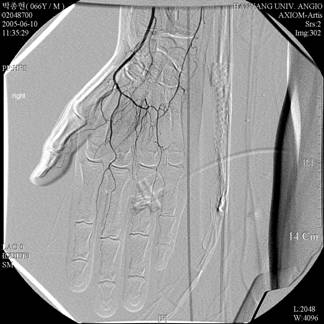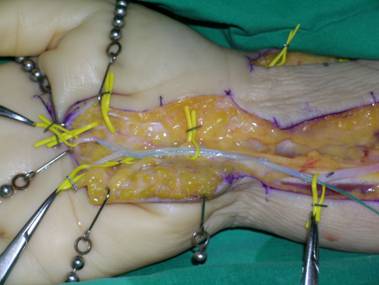Sunday, October 8, 2006
10931
Balloon Catheterization and Digital Artery Sympathectomy for Raynaud's Disease
Purpose: Digital artery sympathectomy is performed on patients with Raynaud's disease to eliminate ischemia pain, alleviate cold intolerance, and increase vascular flow to fingertips. Occluded vessels with short distance obstructions can be corrected by either excision and anastomosis or with an interposition vein graft. However, controversy exists in the management of narrow vessels with incomplete obstruction. We successfully treated such cases by balloon catheter dilation of the ulnar artery, palmar arch, and common digital arteries. The rationale of our protocol is presented.
Materials and Methods: Of 64 patients with Raynaud's disease treated at our department from 2002 to 2005, 21 patients presented with Raynaud's disease. Each patient had an arterial stenosis of at least 5 cm diagnosed by arteriography. All patients had digit cold intolerance, discoloration, and ischemia pain. Twelve patients had fingertip necrosis, ulceration, or osteomyelitis of distal phalanx. All patients were treated with adventitial stripping of the affected radial and ulnar digital arteries, palmar arch, and common digital arteries and by vessel dilatation using a PTCA balloon catheter.
The balloon was inserted into an ulnar artery branch and advanced from the main artery through the Guyon's canal, palmar arch, and common digital arteries. Sequential dilatation was performed by balloon inflation with 6 atm for 40 seconds. The patients were evaluated pre and post-operatively by angiogram, color Doppler, and Thermoscan. The follow up period ranged from one month and two years.
Results: All but one patient reported relief from the ischemia pain. The non-responding patient did not succeed in nicotine abstinence. The patients with fingertip ulceration or necrosis showed complete healing within 2 month period. Thermoscan and Doppler studies demonstrated significant improvement of vascular flow and temperature compared to baseline measurements.
Conclusion: The balloon catheter is an established tool for managing coronary artery disease. However, balloon angioplasty for treating primary and secondary Raynaud's disease has not been reported. The favorable results of our preliminary study indicate that balloon catheter dilatation is a useful adjunct procedure and that it may potentiate the effects of arterial sympathectomy. In addition this procedure can be used for incomplete arterial obstructions up to 15 cm. This technique may eliminate the need for interposition vein grafts. We suggest long term follow up to prove its usefulness.

Figure1: Angiogram of a 66 y-o male with incomplete ulnar artery obstruction.

Figure 2: The balloon catheter is inserted through a branch of the ulnar artery at the distal forearm after sympathectomy and then advanced to the common digital artery with continual dilatation with 6 atm for 40 seconds.

Figure 3: Preoperative view of fingertip necrosis

Figure 4: Postoperative view 6 month after operation
